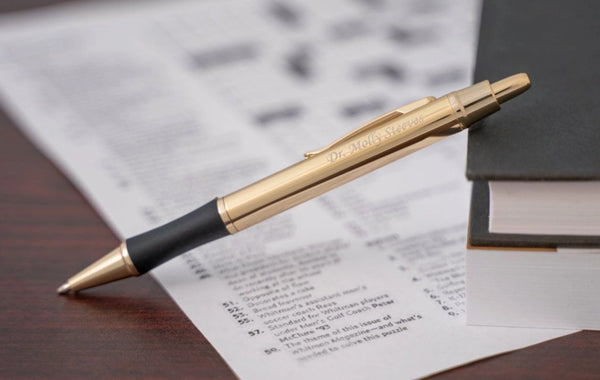The Ultimate Guide to Choosing the Right Pen

The Ultimate Guide to Choosing the Right Pen
In this comprehensive guide, we are going to talk about everything pen-related: writing style, ink, construction, the paper you normally use, the reasons for buying…all to help you find the right pen for your needs.
You can find what you need to know in these chapters:
- Chapter 1: The Pen Design
- Chapter 2: Outside the Pen: Other Factors
- Chapter 3: Who Are You Buying For
Chapter 1: The Pen Design
This section will be about anything and everything regarding the actual pen itself. This means the writing style, what the pen is made of, the ink inside the pen, and the sizing of the pen.
Writing Style
Writing style is just an easy way of saying how the pen delivers ink to the writing surface. The main writing styles are:
Each one has its own particular element that makes it unique.

Ballpoint Pen
Ballpoint pens work by transferring oil-based ink around a rotating ball to paper. Each pen contains a small ball-and-socket mechanism at the tip of the pen.
It's the most versatile of writing styles and works for pretty much any writing surface.
They tend to be the least expensive, easily accessible, and ready to write at any moment.
Fountain Pen
Fountain pens work by using a feed to bring liquid-based ink down to the tip of the pen (called the nib).
The nib offers a tactile writing experience and smooth liquid ink delivery since there is no rotating ball that can jump or skip if the rotation is impeded.
Their major downfall is the level of upkeep and maintenance required.
The best fountain pen can stand up to constant daily use and will give a writing experience completely unique to the user.
Rollerball
Rollerballs (sometimes called rolling ball or select tip pens) are the best of both worlds between a ballpoint pen and a fountain pen.
They have the same ball-and-socket mechanism of the ballpoint with the liquid based ink of a fountain pen so you get a smooth writing experience without the upkeep.
Gel Pen
Gel pens are rollerballs with ink made to showcase ink variety, be more resilient to drying out, write on almost any surface, and dry quickly.
Gel ink is made up of a gel and water solution which makes it hold pigments and dyes at a higher volume ( brighter colors) or can act as a vehicle for additives (glitter).
What kind of ink works best for you
Selecting the right pen for you can often depend on the type of ink inside the pen.
How quickly it dries, how the pen moves across the paper, what color it is—all this comes down to the ink.
There are two main types of ink: water-based and oil-based.
Water-Based Ink

So what are the pros and cons of using water-based ink in your pens?
Pros:
- smooth, flowing ink writing lines
- limited skipping
- doesn't clog inside the pen
- comes in the largest variety of colors
Cons:
- ink dries slower
- water soluble (dissolves if paper gets wet)
- will dry out inside the pen if the pen is left uncapped for a long period of time
- can freeze in colder climates
Oil-Based Ink
Oil-based ink is the most common form of ink used in the world.
Fun fact: Oil-based ink was invented by mimicking the type of ink used to print newspapers.
It's thicker and more viscous which prevents it from drying out quickly inside the pen, and it doesn't smear on the page.
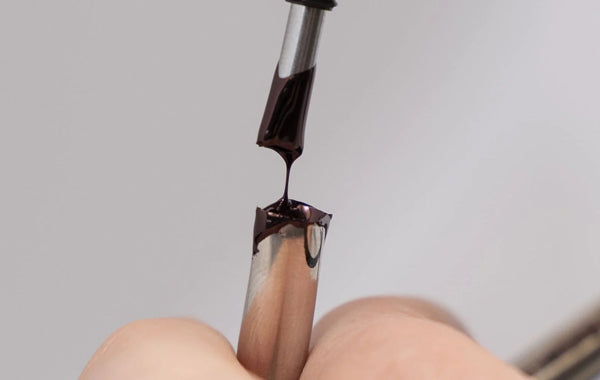
Pros:
- quick drying time
- can write on almost any surface
- does not leak in pressurized environment
- takes much longer to dry out if uncapped
- can handle colder climates since oil has a lower freezing point
Cons:
- requires more writing pressure
- skips more
- leaves harder to clean stains if leaks
- limited colors
Pen Sizing
You could have a writing style you love with really great ink and hate the experience of writing with the pen.
It might just not feel good in your hand.
Here are a few things to consider to help make sure when you are holding the pen it feels comfortable and easy to use for long periods of writing.
Thick vs Thin
Barrel size of your pen is the largest factor in how comfortable a pen feels in your hand. This is because it can cause you to over-grip your pen (hold on too tight).
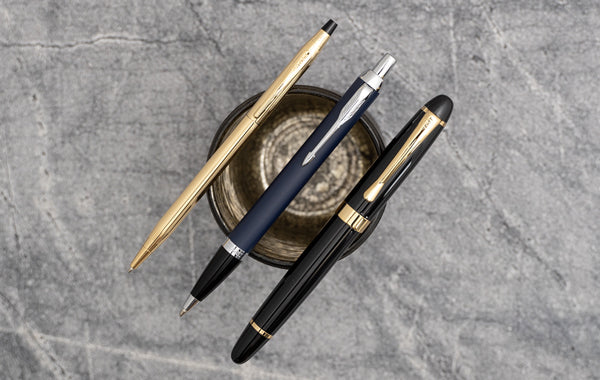
Think about your hand size, finger length, and dexterity.
Thin Barrel Pens: 15-25mm in diameter
Great for more slender fingers, smaller hands, and people who use their fingers for precision tasks.
Medium Barrel Pens: 25-32mm in diameter
A great average size if you aren’t sure what to try or you are buying for someone else.
Thick Barrel Pens: 33mm+ in diameter
Ideal for the larger handed or who like to grip things loosely.
Weight & Balance
Weight factors into balance and how the weight is distributed across the cap and barrel.
Weight affects how easy it is for the user to move the pen along the page.
An even balance of weight from front to back is the best for most writers.
When getting a feel for the weight of your pen, try it with the cap posted (placed on the end of the barrel) and unposted.
Do you like the feel of the extra length and weight or does it bog down the pen in your hand?
Grip
Grip deals with where your fingers make contact with the pen and can be differentiated from the barrel by material or shape.
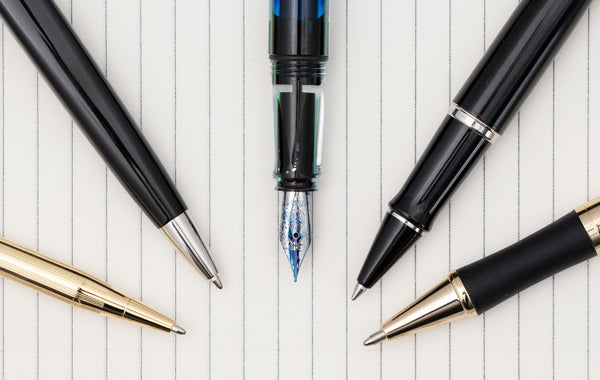
Some pens do not distinguish the grip at all while others make the grip rubber or a softer material for comfort.
In luxury pens, the shape of the grip is often tailored to the design. The grip might taper in or out towards the tip for a natural hand hold or might even be triangular.
Construction Material
The construction material is what the pen is made of, generally the internals of the pen.
Construction materials will have a huge impact on how long your pen lasts and its weight/feel.
Cheaper pens are generally plastic inside and out with some metal components like the tips or springs.
More expensive pens are going to invest quite a bit in the internal workings and materials to deliver a more luxurious writing experience.
Materials can include:
- Plastic
- Resin
- Brass
- Steel
- Tungsten Carbide
The quality of the plastic or metal is going to change exponentially based on price.
Pen Finish
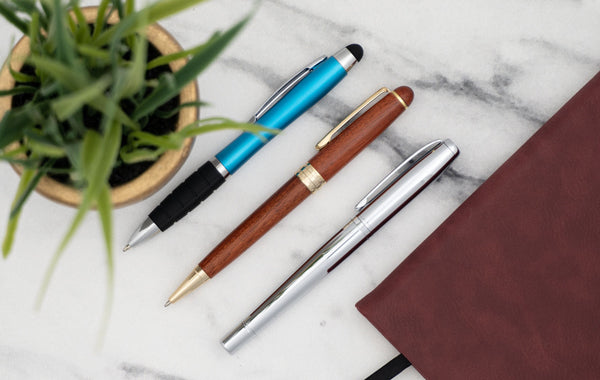
Pen finish deals specifically with what is on the outside of the pen, what is displayed.
To list a few different finishes:
- gold of a variety of karats
- wood
- chrome
- lacquer of any color
- resin
The look of the pen is going to come entirely down to preference. Find what you like.
Chapter 2: Outside the Pen
Now that we have discussed the pen itself, we are going to go into all the factors that have a major impact on buying and using a pen. This includes things like budget, how frequently the pen is used, writing hand, paper, and so on.
What is your budget?
Your budget is a huge determining factor in your shopping.
If you are looking for your favorite cheap, disposable pen (something under $10), it’s always good to give the classics a try (Uniball Roller, Pilot G-2, or a Zebra F-301).
If you are looking for something reusable or a luxury pen, check out our other articles on the subject for ideas on what to find in your budget:
How much do you use a pen?
You've got to consider how much use you're going to get out of the pen.
Are you writing for a long stretch of dedicated time like writing a letter or taking notes, jotting a quick signature, or making marks periodically through the day?
Liquid inks like Fountain Pens and Rollerballs are better for longer writing.
Oil-based or gel inks like Ballpoints and Gel pens are ideal for periodic writing and writing on the go.
Writing Hand
Are you right-handed or left-handed?
Right-handed writing is the most common so all pen styles are easily functional for all the righties out there.
Left handed writers have much more to consider before purchasing a pen.
Ballpoints and oil-based ink pens tend to be the most user-friendly pens for lefties since they dry almost as soon as they come in contact with the paper.
If you are a lefty interested in using a rollerball or fountain pen, there are options out there with fast drying inks, and changing your hand position to rest below the writing line instead of behind it can make any liquid pen usable.
What surface do you write on?
The kind of paper on which you are writing matters for experience, especially when choosing between a liquid ink pen and an oil or gel based pen.
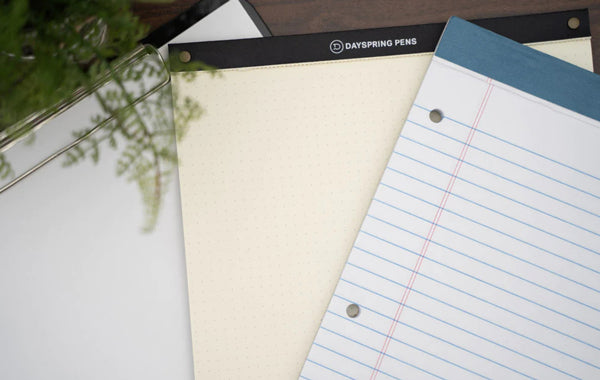
Cheaper paper like newspaper, printer paper, or notebook paper can cause liquid ink to bleed through the paper or feather out so your letters expand into one another.
If you are writing on any of this kind of paper regularly, choose a ballpoint or gel.
If you are writing on stationery or invest in quality paper, fountain pens or rollerballs can be better.
Chapter 3: Who Are You Buying For
This is one of those questions that's really going to direct your shopping efforts.
There's two general categories for who you might buy for: yourself or someone else.
Buying a pen for yourself
Buying a pen for yourself is the simplest category.
You only need to focus on what you want. Think through the different elements discussed and choose what you like.
Buying a pen as a gift
Here's 4 questions to ask yourself when buying for someone else:
- What is their relationship to you?
- What is the occasion for buying?
- What's the purpose of getting them a pen?
- What will they do with the pen?
First, how do you know them? Different relations may dictate how much you spend, what finish you choose, and how personal the gift should be.
Are they your boss, your brother, your spouse?
You can usually intuit a good pen by referencing what you know of their personality.
Are they hardworking? Are they into high fashion? Are they serial note taker?
Second, consider the occasion for buying. Is it a holiday? A birthday? A graduation? A promotion?
A promotion means you should get them something that looks professional. A birthday might mean you get something special for them. An anniversary might mean being really intentional about acknowledging the event.
Just take a second to think about why you are buying the gift.
Third, why are you getting them a pen specifically? Gift pens are great for all occasions; they're super flexible since they can be either sentimental or practical (or both).
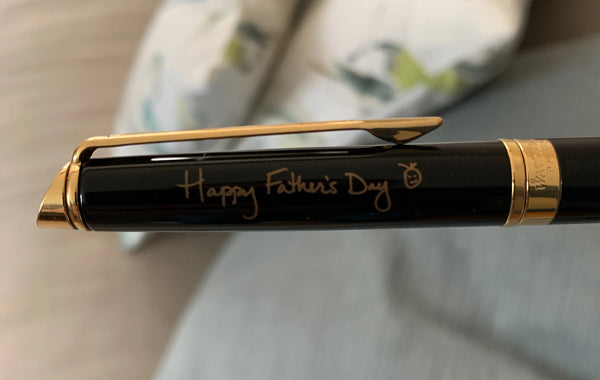
Ask yourself why you want to give them a gift and what it means to give them a pen.
Finally, what will your recipient do with the pen? Is this a useful tool for them? Or is it more of a symbolic gift?
If it's a useful gift, then getting the highest quality writing tool for a lower price point is totally acceptable.
If it's a symbolic gift, you might want to aim for something more luxurious with finer finishes.
What are your priorities in a pen?
Now that we have talked about all the different features to consider when looking for a pen, the last major thought comes down to priorities.
Are you looking for a pen that writes smoothly, but you could care less how it looks?
Are you walking into business meetings with clients who are going to notice a beautiful pen?
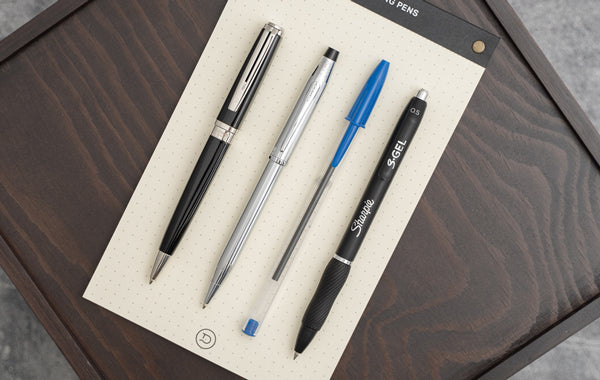
Think about how you are going to be using your pen and if you need it to be an extension of how you present yourself.
A great cheap plastic ballpoint and a luxurious gold-inlaid fountain pen can both be the right choice for you depending on your situation.
Customizing your pen
Here are some thoughts on personalizing your pen:
Imprinting will print the image directly onto the surface or the pen.
Engraving will carve into the finish which will be more permanent.
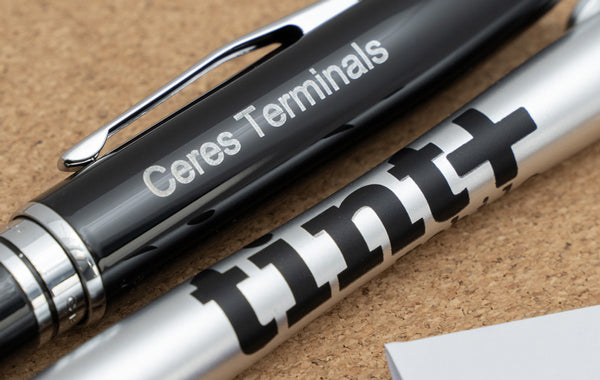
Whether it is a logo, handwriting, or simple text, you can put it on a pen with these methods.
Conclusion
Pen buying doesn't have to be overwhelming! Even though we brought up a lot of things to consider when buying a pen, at the end of the day the best pen is the one you love and love to share.
Pick your writing style, decide how much you want to use the pen, and go out there and find a pen that makes you excited to use it and give it.
You can also think about getting your pen personalized!
|
Sam Di Nardo is an author for Dayspring Pens, where she has honed her expertise in ballpoint, rollerball, gel and fountain pens since joining the team in 2018. From her initial role as an Engraver to becoming the Production Manager, Sam's journey has been marked by her passion for the history, manufacturing, and the unique value of gifted writing instruments. A graduate of Regent University with a degree in English Literature and a special interest in Old Norse literature, dive deeper into Sam's world and discover why she's your trusted guide in the realm of gift pens. |
